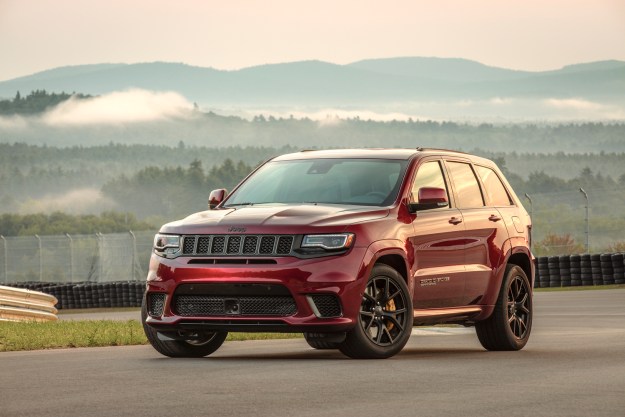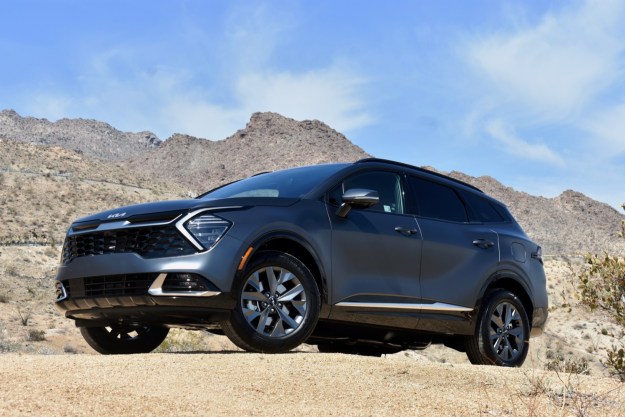
“With 707 horsepower on tap, Jeep’s outrageous Grand Cherokee SRT Trackhawk is absolutely unrivalled.”
- Absurdly fast for an SUV
- Consistent off the line
- Holds its own on a technical road course
- Maintains the on-road luxury experience
- Pricey for a Jeep
- Poor fuel economy when driven hard
A 707-horsepower sport utility vehicle seems a bit out of step with a car industry that’s currently fixated on electrifying everything and taking the driver out of the equation whenever possible. And even to gas-mileage-be-damned enthusiasts, the concept of a high-riding SUV with super car-like capability is a bit of a curiosity. As we discovered in our 2018 Jeep Grand Cherokee SRT Trackhawk review, it’s a sentiment that hasn’t been lost on Jeep’s brass.
“You might be asking yourself the question, ‘Why make this vehicle?’” Jeep brand director Scott Tallon confessed to a room full of journalists before our test drive. With a 6.2-liter supercharged Hemi V8 under the hood, along with hardware from the likes of Brembo, Bilstein, and other racing name plates – this track-focused machine seems out of step for a company that built its reputation on crawling over rocks. But Tallon assured us that the Trackhawk’s actions would speak louder than words.
Since the debut of the Dodge Challenger and Charger SRT Hellcat models in late 2014, enthusiasts have been demanding that Fiat-Chrysler “Hellcat all the things.” While we’re probably still a ways off from a Fiat 124 Abarth Hellcat, the Grand Cherokee Hemi compatibility made it a likely candidate for Hellcatification.
The Grand Cherokee also attracts more well-heeled buyers than most of FCA’s other brands. With the current naturally aspirated Grand Cherokee SRT already garnering accolades around the industry (including from us), developing an over-the-top high performance version actually made sense, on some level.
At a glance, one might be forgiven for overlooking the Trackhawk in a crowd. Aside from some badging, it offers very few visual cues to differentiate it from the standard Grand Cherokee SRT, which isn’t dressed up much to begin with. There are some tells here, however, like the unique yellow brake calipers and the quad-tipped exhaust system. On the street, the understated appearance of this supercharged monster works to its benefit, making its unexpected capabilities that much more shocking when you experience them.
And experience it we did, both on the back roads and highways surrounding Portland, Maine and at the Club Motorsport road course in Tamworth, NH.
What’s new
While the Jeep brand might be synonymous with off-road capability, the Trackhawk is far from its first foray into on-road performance. The concept dates all the way back to 1998, when Jeep debuted the Cherokee Limited 5.9, one of the quickest SUVs of its day. It delivered a sports car-like dash to 60 miles per hour from a standstill in under seven seconds.
Enthusiasts have been demanding that Fiat-Chrysler “Hellcat all the things.”
The Limited 5.9 would prove to be a harbinger of high performance Grand Cherokees to come. An SRT-tuned package would follow in 2006, cutting that 0 to 60 time down to a brief 4.8 seconds by way of a 6.1-liter 425 horsepower Hemi V8, while also delivering significant chassis and appearance upgrades for good measure. On sale since 2012, the current generation SRT-tuned Grand Cherokee has received regular updates to keep it fresh, but in order to really bring the heat to newer entries into the segment like the Range Sport Sport SVR and Mercedes-AMG GLE 63 S, Jeep and SRT needed to step up their game.
They found the necessary 707-horsepower adrenaline shot in the Hellcat parts bin. “But this is not just an engine swap into an existing Cherokee,” Tallon reminded us. To that end, SRT also developed stouter chassis components to handle the newfound grunt, giving the car better durability and balance to match its speed.
Trim levels and features
Those tweaks might keep it grounded, but the star of the show is undoubtedly the supercharged 6.2-liter V8. Here that blown mill dishes out 707 horsepower and 645 pound-feet of torque, losing 5 lb-ft compared to its Dodge brethren due to the need for slight more restrictive exhaust manifolds. A specially developed version of ZF’s eight-speed automatic gearbox sends that power to all four wheels.
Of course, with 700 horsepower on tap, the Trackhawk needed stopping power to match. Six-piston Brembo calipers clamping down on 15.75-inch rotors can slow this 5,500-pound behemoth from 60 to a dead stop in just 116 feet. Four-piston units are installed in the rear.
The suspension also gets unique tuning for Trackhawk duty with the three-mode Bilstein adaptive dampers that are designed to offer compliance around town in Auto mode and flat cornering on the road course in Sport and Track modes.
To give customers the luxury they expect from an $85,900 vehicle, the Trackhawk’s interior boasts Laguna leather seating, carbon-fiber accents, and other premium touches.
Technology overview
Like the standard Grand Cherokee SRT, the Trackhawk benefits from FCA’s excellent Uconnect system, which includes plenty of performance-focused widgets. One new element allows users to see telemetry information – like G forces and speed — graphed over an entire ride. That means you can actually review and analyze your driving performance, rather than just giving passengers a novelty on thrill rides.
A 2017 refresh brought the Uconnect system some significant upgrades, so the visuals are crisp, and the hardware is fast enough to keep tech-savvy users from getting frustrated.
Don’t worry though, not all the technology is behind a screen. The Trackhawk also utilizes some of the Challenger SRT Demon’s Torque Reserve tech in its launch control system. It provides 6.4 psi of supercharger boost off the line, and jaw-dropping acceleration as a result.
Interior fit and finish
Inside, the Trackhawk shares the lion’s share of its layout and aesthetic with the standard Grand Cherokee SRT, though that’s certainly not a bad thing.
It’s tuned for serious performance, but the Grand Cherokee SRT Trackhawk still knows how to grand tour with the best of them.
Both steering wheel and center console controls are easy to access, and altering the behavior of the vehicle is as simple as a twist of the Drive Mode knob, located just in front of the cup holders on the center console.
Well-bolstered SRT sport seats keep occupants planted as you fling the Trackhawk around curves, while remaining eminently comfortable during long drives. It’s tuned for serious performance, but the Grand Cherokee SRT Trackhawk still knows how to grand tour with the best of them.
Like the rest of the Grand Cherokee lineup, the Trackhawk seats five with 105.4 cubic feet of passenger volume. Total cargo volume is 68.3 cubic feet with the rear seats down, or 36.3 cu-ft with the rear seats up.
Driving performance and MPG
Make no mistake: the Trackhawk’s straight-line acceleration is nothing sort of stunning. 3.5-second blasts to 60 mph are repeatable, effortless, and only a tenth of a second behind that of the Dodge Challenger SRT Hellcat Widebody. The experience of moving an object as large as a Grand Cherokee at this rate of speed is flat-out awe inspiring.
Due to its high center of gravity, most track rats won’t soon confuse the Trackhawk with a sports car out on a road course, but this Grand Cherokee admirably holds its own, even on a technical course like Club Motorsports’. There’s a reasonable amount of grip on hand from the optional three-season Pirelli P Zero tires, minimal body roll from the suspension in its most aggressive setting, and any short comings the Trackhawk might have in the corners are more than made up for once the road straightens out. A Lotus Elise it is not, but we wouldn’t be surprised to see one of these things embarrass some very expensive machines at a track day in the near future.
Of course with a massive supercharged Hemi and 5,500 pounds of heft to move around, it shouldn’t be surprising to discover that the Trackhawk will consume fuel at a very brisk pace when hammered on. Official EPA numbers put the supercharged Grand Cherokee at 11 mpg city, 17 mpg highway and 13 mpg combined.
Safety
While the 2018 has yet to be tested by the IIHS or NHTSA, the latter gives the ’17 4×4 model a five-star overall rating, while the IIHS gives the 2017 Grand Cherokee “Good” ratings for roof strength along with moderate overlap and side impacts, and a “Moderate” rating for small overlap front impacts.
In terms of safety tech, the Trackhawk comes equipped with blind-spot monitoring, forward-collision warning with automatic braking, rear cross-path detection, trailer sway control, and other active features.
Conclusion
When we reviewed the naturally aspirated Grand Cherokee SRT last year, we noted that its ample power, high levels of comfort, and overall ease of use equated to a very convincing “king of the road” vibe. The Trackhawk raises that bar to a nearly absurd degree, dishing out tidal waves of power in a way that shouldn’t be possible in a luxury machine that coddles passengers this much.
Although it wouldn’t be our first choice for a road course weapon, we suspect that most performance enthusiasts who can afford the Trackhawk’s $85,900 starting price likely have at least one other vehicle that’s even better suited to the task. Even for those who don’t, there’s plenty to like about the Jeep Grand Cherokee SRT Trackhawk – both on and off the racetrack – provided you’ve made your peace with its shameless celebration of grin-worthy high performance.
Editors' Recommendations
- Mercedes-AMG EQE SUV first drive review: a better electric SUV
- Mercedes-Benz EQE SUV first drive review: ’90s look, cutting-edge tech
- 2023 Kia Niro EV first drive review: Practical doesn’t have to bore you to tears
- 2022 Mercedes-Benz EQB first drive review: An EV better than its gas sibling
- 2022 Rivian R1S first drive review: An EV SUV fit for an expedition or a drag race









